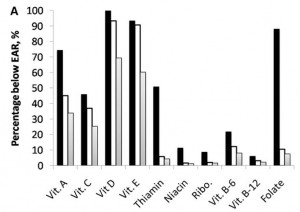You should be ashamed of yourself!
Foods, fortificants, and supplements: where do Americans get their nutrients? (Fulgoni et al., 2011 Journal of Nutrition)
The Journal of Nutrition just published an analysis of micronutrient intake in healthy Americans. The dataset came from the National Health and Nutrition Examination Survey (NHANES), which is run by the Centers for Disease Control (CDC) and the National Center for Health Statistics (NCHS).
The USDA database was their primary source for nutrient information, but the Food and Nutrient Database for Dietary Studies (FNDSS) and Nutrient Database for Standard Reference (SR) were also consulted when appropriate values were unavailable. As the authors faithfully noted in the methods section, these registries are not perfect, but they really did do a lot of footwork to get accurate, up-to-date data.
Importantly, intake from whole foods, processed foods, and supplements was differentiated. AND bioavailability was taken into account! Kudos.
Shamefulness: over half of you are not getting enough vitamins D and E, and many are not getting enough vitamins A and C, and magnesium and calcium.
And if it weren’t for processed foods, too many of you would be consuming too little thiamin, niacin, riboflavin, and folate! Why are you dependent on processed foods for vitamin sufficiency!?!
In the graph below, the higher the solid bars, the more people are vitamin insufficient if only whole foods are considered. Notice that when processed foods are taken into consideration, the values are much lower for thiamin, niacin, riboflavin, and folate (open bars). And supplements don’t add a whole lot to the picture (shaded bars).
Supplements don’t change the big picture very much because, well, who takes supplements? Healthy people. Healthy people who are probably already getting enough vitamins and minerals from the whole foods in their diet. Someone who lives on fast food, soda, and crisps probably doesn’t care enough about their health to swallow a multivitamin every morning. However, their intake is not suboptimal because they don’t take a multivitamin pill, it’s suboptimal because their diet contains too many empty calories!
TO DO: from whole food sources (i.e., not empty calories), get more:
Magnesium: spinach
Vitamin A: red meat, chicken, spinach, kale
Vitamin C: berries, broccoli, kale, peppers
Vitamin D: salmon/fish, whole eggs, red meat, liver
Vitamin E: spinach, nuts, fish
Potassium: spinach, tomatoes, beans
And while “adequate is adequate,” stop relying on processed foods and start eating more whole foods for:
Folate: foliage (leafy vegetables like spinach), also high in turkey, chicken, beans, etc.
Thiamin: pork, and lesser amounts in liver, whole eggs, nuts
Iron: red meat
processed foods are empty calories. a processed food that has been chemically fortified with a synthetic vitamin cocktail is still “empty calories” in my book. And although frank toxicity is rare, processed foods are close to providing too much of certain nutrients, e.g., niacin, vitamin A, folate, and zinc. Stick to whole foods, and don’t overdo it with your kids- they were more likely than adults to be getting too much zinc, niacin, vitamin A, and folate, and the overage was largely due to processed foods.
Calories proper

